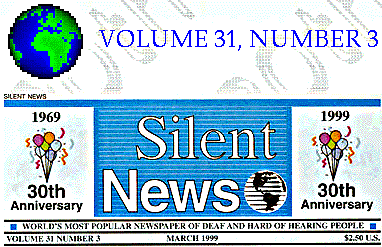|
|
|
|
|
|
 |
|||
|
|||
|
A Controversial Approach to Communication: SignWriting, The "Alphabet" of Signs by Alexandra Han |
|||
|
Twenty-five years after it was invented by a hearing woman and dancer who never originally intended to use her "Sutton Movement Writing" to record sign languages, SignWriting continues to face a great deal of opposition and ridicule even within the signing communities in North America for its primary goal: to create written versions of sign languages, just as spoken languages have their written versions. Yet SignWriting, with its computer software which allows even children to type signs into sentences, may ultimately turn out to be the most accurate way of recording into print form the hundreds of native sign languages that exist worldwide for many purposes, including linguistic (languages), educational, or simply reading-for-pleasure purposes. The Center For Sutton Movement Writing, in California, is the primary advocating organization for SignWriting, which has been used in other countries such as Norway, Nicaragua, Brazil and Denmark, for linguistic and educational purposes. Ironically, even though SignWriting was originally invented in a lingusitics lab with the advice and assistance of many native ASL signers, Denmark still became the first country to officially adopt SignWriting, using SignWriting in Deaf education and sign language research since 1982. As for North America itself, only very recently has a few schools of the Deaf begun to consider SignWriting, although "things are changing now. People are now much more positive than before," says Valerie Sutton, inventor of SignWriting and executive director of the Center For Sutton Movement Writing. But just what exactly is SignWriting? "It is an 'alphabet' - a list of symbols used to write any signed language in the world," replies Sutton. The SignWriting alphabet can be compared to the alphabet we use to write English, which is the Roman alphabet." "The Roman alphabet can be used to write many different spoken languages. While each language may add or subtract one or two symbols, the same basic symbols we use to write English are used to write Danish, German, French and Spanish. The Roman alphabet is international, but the languages it writes are not."
"In the same way, the symbols in the SignWriting alphabet are international and can be used to write American Sign Language, Danish Sign Language, Norwegian Sign Language, British Sign Language, Dutch Sign Language - any signed language you choose." As for its value, "SignWriting makes it possible to have books, newspapers, magazines, dictionaries and literature written in signs. It can be used to teach sign and sign grammar to beginning students, or it can be used to teach other subjects, such as math, history, or English to skilled signers." |
|
|
|
|
|
|
SignWriting
In The USA Literacy Projects in American Schools |
|
|
The Albuquerque
Public Schools SignWriting Literacy Project Letters & Web Reports, Mona Sherrell & Cecilia Flood |
|
|
Classroom Experiences
Teaching SignWriting in the Albuquerque Public Schools Excerpts from email messages by Cecilia Flood |
|
|
Research Project ...Cecilia Flood 1999 & continuing... |
|
|
...other Silent News articles... A New Controversial
Approach to Literacy: ...by Alexandra Han.... |
|
|
|